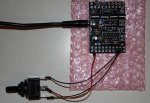Hello ,
I have 2 questions regarding the CHI035 board...
1)
I want to power it with a 12v car battery.
The pdf document states that for a single Battery Pack 7.5-12v I must use a regulator.
My car battery is around 12.7V and when my engine is running it's around 13.5v.
Will this be a problem as it's above the specified 7.5-12v range?
2)
My project involves a slow revs 12v dc motor.
I don't need the forward/reverse functionality of the optional L293D chip that the CHI035 supports.
However there is a possibility that my motor could become overloaded or even jam during operation.
As I've never used the L293D chip before I don't know if it supports motor cutout ?
Ideally I want the motor to cut out over 1.5A.
Any suggestions for a solution for this?
Much appreciated
I have 2 questions regarding the CHI035 board...
1)
I want to power it with a 12v car battery.
The pdf document states that for a single Battery Pack 7.5-12v I must use a regulator.
My car battery is around 12.7V and when my engine is running it's around 13.5v.
Will this be a problem as it's above the specified 7.5-12v range?
2)
My project involves a slow revs 12v dc motor.
I don't need the forward/reverse functionality of the optional L293D chip that the CHI035 supports.
However there is a possibility that my motor could become overloaded or even jam during operation.
As I've never used the L293D chip before I don't know if it supports motor cutout ?
Ideally I want the motor to cut out over 1.5A.
Any suggestions for a solution for this?
Much appreciated



